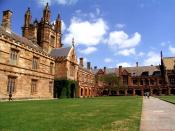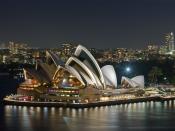The vast territories formerly known as New Holland and Van Dieman's Island and since 1900 as The Commonwealth of Australia were erected to the Vicariate Apostolic of New Holland in 1834. John Bede Polding (q. v.), a Benedictine, was vicar Apostolic. He was consecrated bishop in London on 29 June, 1834. Dr. Polding visited Rome in 1841-2, and at his suggestion new sees were erected in Hobart and Adelaide. A few years later Melbourne and Brisbane were also detached from the archdiocese. In New South Wales dioceses were erected at Maitland, Goulburn, Bathurst, Armidale, Lismore, and Wilcannia; these form at present the suffragan sees of Sydney, which was erected into an archdiocese on 15 February, 1842. The archdiocese stretches along the Pacific coast from the Red Head on the north to Cape Howe on the south, and inland to the Dividing Range. When Dr. Polding landed at Sydney there were only four priests in the district; Father Ullathorne, an English Benedictine, who had come to Australia in 1833, was vicar general, assisted by Fathers Therry, McEnroe, and Dowling, three Irish priests, the last-named a Dominican.
The official census of 1833 gave the population of the colony as 60, 794, the Protestants of all denominations being 43,095, and the Catholics 17, 283. The government allowance in the same year for the maintenance of the Catholic Church was $4000, whereas the Church of England, exclusive of its rich land endowments, was assigned the sum of $95,355. There were ten Catholic schools receiving about $2000 from the Government, whilst the Protestant schools were allowed $28,680, in addition to a grant of $16,500 for the building of the Protestant King's School at Parramatta. In 1836, Dr. Ullathorne sailed for England and Ireland to secure priests and nuns for the increasing demands of the diocese.


